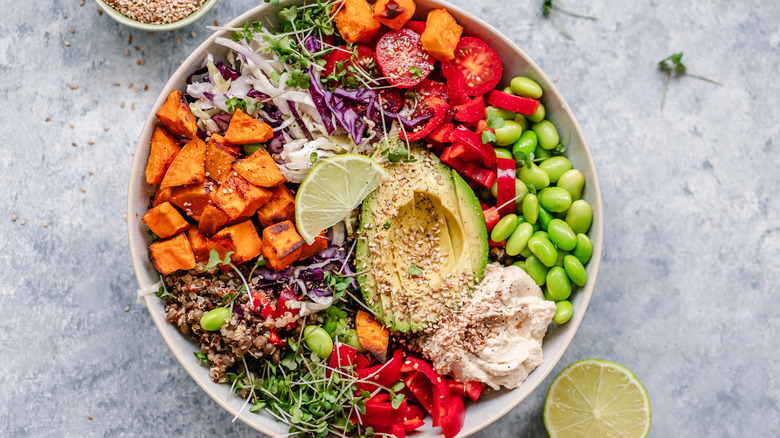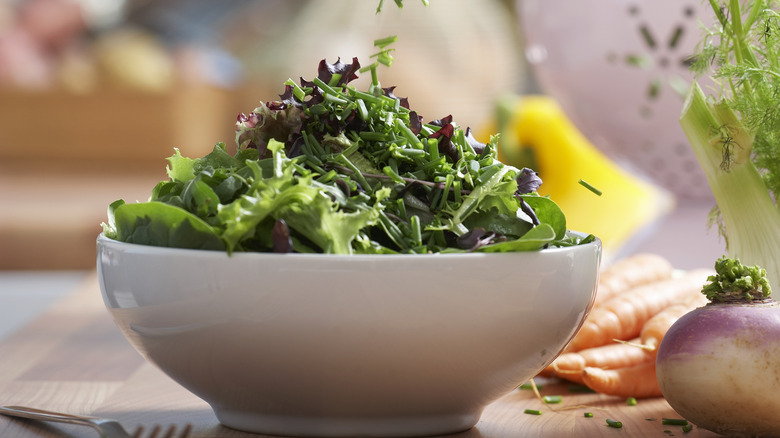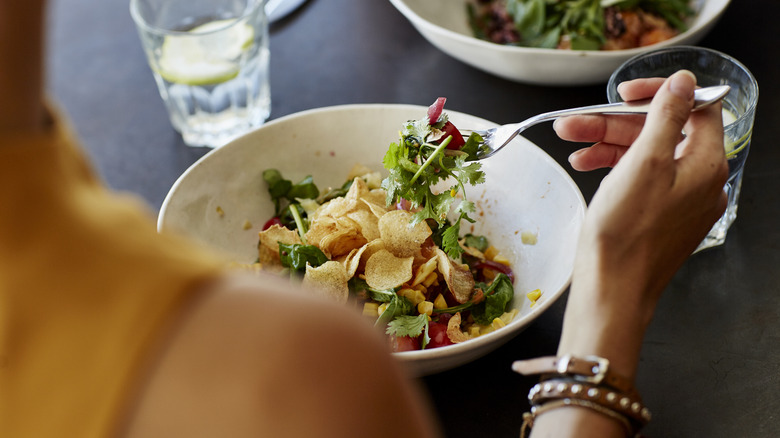The Ultimate Formula For A Drool-Worthy Salad Every Time
Some say that cooking is simply formulas, and recipes are just for reference until you know enough to make your own rules (baking excluded). Salads are the perfect entry to formulaic dishes and endlessly iterable. As long as you hit the correct elements in the right amounts, you're nearly always guaranteed to end up with an excellent salad.
The basic elements are veggies, protein, soft, crunchy, sweet, and acidic. Balancing these six components is the key to a perfect, craveable salad. Although people of the Midwest may disagree, the base of a salad should generally be leafy vegetables. Then start building layers, first by adding protein for a filling energy boost. Next add some texture by offsetting something creamy — like avocado, roasted veggies, or goat cheese — with something crunchy — such as nuts or dense, chopped veggies. Then, to top it all off, add contrasting flavors: Sweet and tangy, like fruit and vinaigrette, round out the saltiness and creaminess of the textural ingredients.
How much of each element should you add in? That formula will depend on what you want from your salad. Though most salads follow a structure of between 2:1 and 4:1 leafy green to everything else, no one will judge you if your salad is mostly cheese or heavy on the rotisserie chicken.
All about balance
Everything in your salad should balance each other. The more delicate your layered ingredients, the more delicate your greens should be — on one end of the spectrum is mache and baby gem lettuces, and on the other is red leaf lettuce and, sure, romaine and iceberg. If you're starting with a sturdy, crunchy green like kale, cabbage, or shaved Brussels sprouts, you should first massage them with some salt to break them down a bit, and then you should match the robustness with chunky, bold toppings. Somewhere in between is the chicory family, like endive, escarole, and radicchio, and heavier greens like chard, spinach, and even arugula.
The ingredients can pull double duty. Glazed nuts, for example, are crunchy and sweet. If you add an additional sweet element, like fresh berries, you'll need to balance that with extra zinginess — perhaps from a particularly tart dressing. Alternatively, dried cranberries or green apple would give you that extra zippy note while also being a bit sweet; they'd balance the flavors of the glazed nuts with their own flavor combo. A protein like popcorn chicken or roasted chickpeas also offers crunch. Grilled steak and hardboiled egg (hopefully) don't, so you should increase that salad's crunch factor with other crispy elements.
Where do you begin to formulate?
Any part of the salad can be the star you navigate around — it doesn't have to be a bottom-up design. Are you craving a heap of blue cheese? That's a lot of salty creaminess, so the other elements of your salad will need to back it up with crunch, sweetness, and acidity. Or maybe you'd like to use goat cheese — it's creamy, but less salty, and there's a tang to it. A goat cheese salad won't need as much extra acidity as the blue cheese salad, but it will need more salty, crunchy bits.
With a creamy dressing, you'll want salty and crunchy elements — that's why steakhouse iceberg salads with bacon work so well with ranch or blue cheese. But they're not the only ingredients that can balance creaminess. Diced vegetables like carrots, peppers, cucumbers, and onions are easy additions for crunch, as are croutons (or, if you're making a Pittsburgh salad, french fries).
Do you have a pile of spring mix in the fridge that might turn bad if you look at it wrong? Search the kitchen for your most delicate ingredients or ingredients you can make delicate. Shave carrots into ribbons for crunch, or add tender berries for sweetness. A soft cheese, like goat cheese or even a dollop of mascarpone, can pair with subtle crunchiness like pepitas or other seeds. A zippy vinaigrette and leftover steak could round it out, and your scraps have become a perfect salad.


